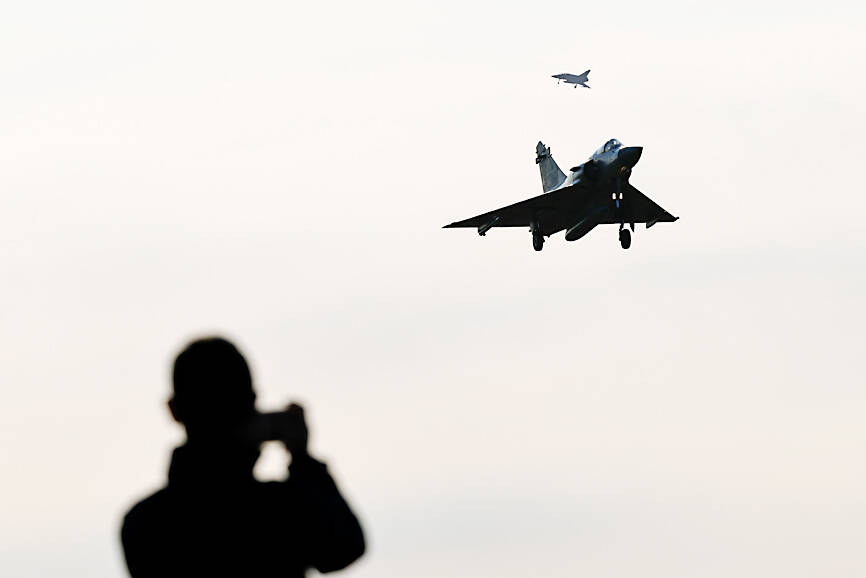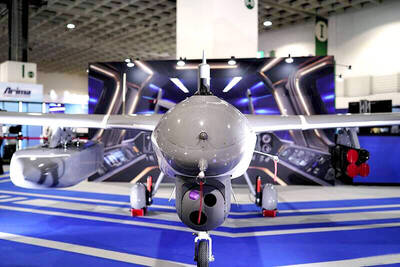The uptick in China’s military activity on Monday formed two “walls” east of Taiwan that aim to secure control of the Taiwan Strait and block the access of other countries, a Taiwanese defense official said yesterday.
In a statement issued yesterday morning, the Ministry of National Defense (MND) said it had detected 21 Chinese vessels — 12 warships and nine official ships — in Taiwan’s vicinity, although it did not specify the exact area involved.
That is significantly fewer than the roughly 90 Chinese ships that Reuters, quoting an unnamed security official, had reported as being “near” Taiwan on Monday.

Photo: Ritchie B. Tongo, EPA-EFE
Asked about the difference at a news conference, Lieutenant General Hsieh Jih-sheng (謝日升), head of the ministry’s Office of Deputy Chief of General Staff for Intelligence, said the ministry’s intelligence showed only 21 ships were near Taiwan.
Hsieh said the about 90 ships reported by Reuters were likely an aggregate of information, and included Chinese ships logged by Japan and other neighboring countries in a larger area.
While declining to comment on the specific locations of the approximately 70 other ships, Hsieh said the deployments by the Chinese navy extended to the West Pacific in an area between the first and second island chains, forming a “wall.”
Meanwhile, a larger-than-usual fleet of Chinese ships had formed another wall in waters east of the country inside Taiwan’s air defense identification zone (ADIZ), Hsieh said.
“With these two walls, they are sending a clear message: The Taiwan Strait is their internal waters, and cross-strait issues should be handled by the [Chinese] People’s Liberation Army (PLA) and the People’s Republic of China,” Hsieh said.
The first island chain refers to the archipelago consisting of the Aleutian Islands, the Japanese archipelago, South Korea, the Ryukyu Islands, Taiwan, the Philippines and the Greater Sunda Islands.
While China’s military maneuvers around Taiwan since Monday are not “military exercises,” and China has not announced the start of any military exercises in Taiwan’s vicinity, it has deployed several PLA theaters-worth of naval force to the West Pacific where it has formed a “considerable area denial force against foreign forces,” Hsieh said.
An “area denial force” refers to a military capability or strategy designed to prevent or restrict the movement of enemy forces into a specific area.
The defense ministry has not ruled out the possibility of China escalating its current military deployments into a drill or an attack on Taiwan, because it is always prepared for worst-case scenarios, Hsieh said.
Major General Tung Chi-hsing (董冀星) from the ministry’s Office of the Deputy Chief of the General Staff for Operations and Planning added that deployments by the armed forces factored in surprise enemy attacks and took into account what the enemy would most likely do next and how the situation could evolve.
For example, the military has conducted combat-preparedness exercises and ordered troops to take their strategic positions according to wartime deployments based on the current threats, Tung said.
Meanwhile, the ministry recorded 47 PLA aircraft in Taiwan’s ADIZ in the 24-hour period starting at 6am on Monday.
Of those aircraft, which included fighter jets and drones, one crossed the Taiwan Strait median line, while 15 crossed its extension and entered the southwestern part of the ADIZ, a flight map released by the ministry showed.
Also on Monday, the independently run US Naval Institute News reported that three US carrier strike groups were active in the west Pacific.
The strike group of Nimitz-class aircraft carrier the USS George Washington remained at the Yokosuka Navy Base in Japan, the strike group of the same-class carrier the USS Abraham Lincoln was sailing westerly and away from the South China Sea, and the strike group of the USS Carl Vinson, another ship of the class, was operating to the east of Taiwan in the Philippine Sea, the outlet’s fleet tracker showed.
The Carl Vinson recently conducted air exercises and received replenishment from an oiler, images published in the warship’s Facebook account showed.
Additional reporting by Aaron Tu

‘WIN-WIN’: The Philippines, and central and eastern European countries are important potential drone cooperation partners, Minister of Foreign Affairs Lin Chia-lung said Minister of Foreign Affairs Lin Chia-lung (林佳龍) in an interview published yesterday confirmed that there are joint ventures between Taiwan and Poland in the drone industry. Lin made the remark in an exclusive interview with the Chinese-language Liberty Times (the Taipei Times’ sister paper). The government-backed Taiwan Excellence Drone International Business Opportunities Alliance and the Polish Chamber of Unmanned Systems on Wednesday last week signed a memorandum of understanding in Poland to develop a “non-China” supply chain for drones and work together on key technologies. Asked if Taiwan prioritized Poland among central and eastern European countries in drone collaboration, Lin

The Chien Feng IV (勁蜂, Mighty Hornet) loitering munition is on track to enter flight tests next month in connection with potential adoption by Taiwanese and US armed forces, a government source said yesterday. The kamikaze drone, which boasts a range of 1,000km, debuted at the Taipei Aerospace and Defense Technology Exhibition in September, the official said on condition of anonymity. The Chungshan Institute of Science and Technology and US-based Kratos Defense jointly developed the platform by leveraging the engine and airframe of the latter’s MQM-178 Firejet target drone, they said. The uncrewed aerial vehicle is designed to utilize an artificial intelligence computer

Renewed border fighting between Thailand and Cambodia showed no signs of abating yesterday, leaving hundreds of thousands of displaced people in both countries living in strained conditions as more flooded into temporary shelters. Reporters on the Thai side of the border heard sounds of outgoing, indirect fire yesterday. About 400,000 people have been evacuated from affected areas in Thailand and about 700 schools closed while fighting was ongoing in four border provinces, said Thai Rear Admiral Surasant Kongsiri, a spokesman for the military. Cambodia evacuated more than 127,000 villagers and closed hundreds of schools, the Thai Ministry of Defense said. Thailand’s military announced that

CABINET APPROVAL: People seeking assisted reproduction must be assessed to determine whether they would be adequate parents, the planned changes say Proposed amendments to the Assisted Reproduction Act (人工生殖法) advanced yesterday by the Executive Yuan would grant married lesbian couples and single women access to legal assisted reproductive services. The proposed revisions are “based on the fundamental principle of respecting women’s reproductive autonomy,” Cabinet spokesperson Michelle Lee (李慧芝) quoted Vice Premier Cheng Li-chiun (鄭麗君), who presided over a Cabinet meeting earlier yesterday, as saying at the briefing. The draft amendment would be submitted to the legislature for review. The Ministry of Health and Welfare, which proposed the amendments, said that experts on children’s rights, gender equality, law and medicine attended cross-disciplinary meetings, adding that